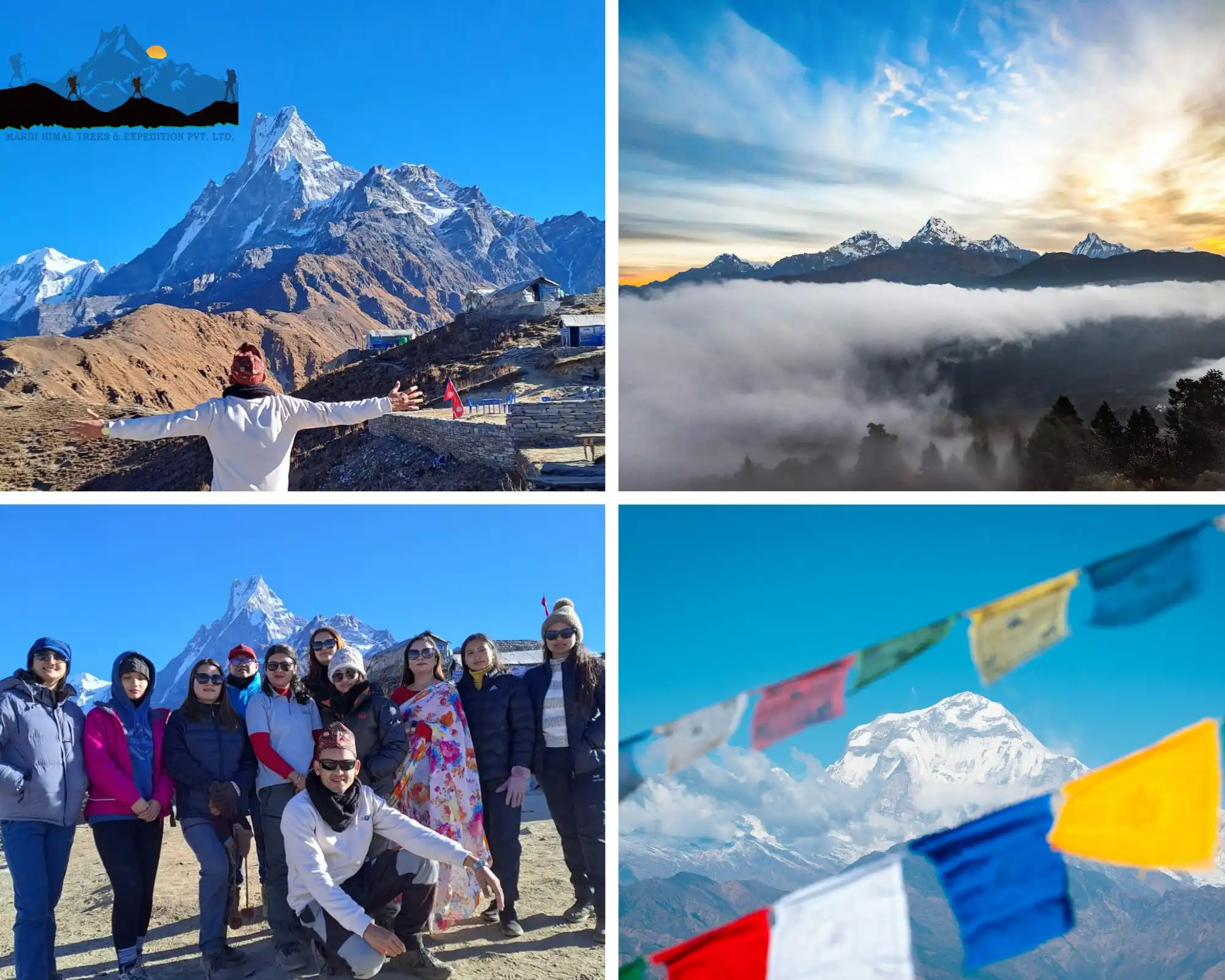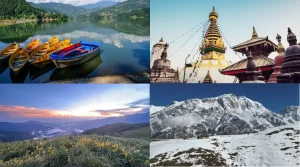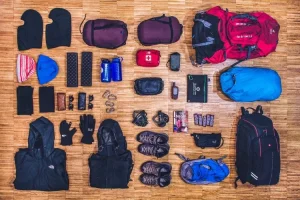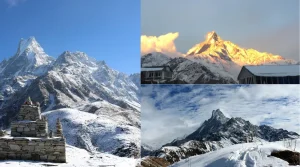Introduction
If you plan to experience the Mardi Himal Trek via Poon Hill, it offers a unique blend of natural beauty, cultural immersion, and adventure. This trek takes you through some of the most picturesque landscapes in Nepal, providing an off-the-beaten-path experience that is both rewarding and manageable for trekkers of various skill levels.
Whether you’re an experienced trekker or a novice adventurer, this journey offers breathtaking views of the Annapurna Range without the Annapurna Trek experience, vibrant local culture, and a chance to explore the less-traveled paths of the Himalayas.
Why Choose the Mardi Himal Trek via Poon Hill?
Unparalleled Natural Beauty
The Mardi Himal Trek is gaining popularity for its serene trails and stunning views of the Annapurna Range, including the majestic Machapuchare (Fishtail Mountain). Unlike busier trekking routes like the Annapurna Base Camp Trek or Everest Base Camp, the Mardi Himal Base Camp Trek offers a more intimate experience with nature.
The landscapes you traverse are remarkably diverse:
- Lush rhododendron forests and terraced fields
- Alpine meadows with wildflowers
- Rugged mountain terrain with panoramic vistas
- Traditional Gurung and Magar villages
Best View from Poon Hill
Adding a detour to Poon Hill elevates this trek significantly, as this is considered a short trek in Nepal. Poon Hill (3,210m/10,531ft) is renowned for its spectacular sunrise views over the Annapurna and Dhaulagiri ranges. This combination provides:
- 360-degree panoramic mountain views
- Less crowded trails compared to standalone routes
- Cultural immersion in authentic Gurung villages
- A perfect balance of challenge and accessibility
Cultural Immersion
The trek passes through traditional villages where you can:
- Experience authentic Nepali hospitality in local teahouses
- Learn about Gurung and Magar cultures and traditions
- Savor local delicacies like dal bhat, momo, and traditional bread popular among the Gurung communities
- Participate in cultural exchanges with friendly mountain communities
Best Time for Mardi Himal Trek via Poon Hill
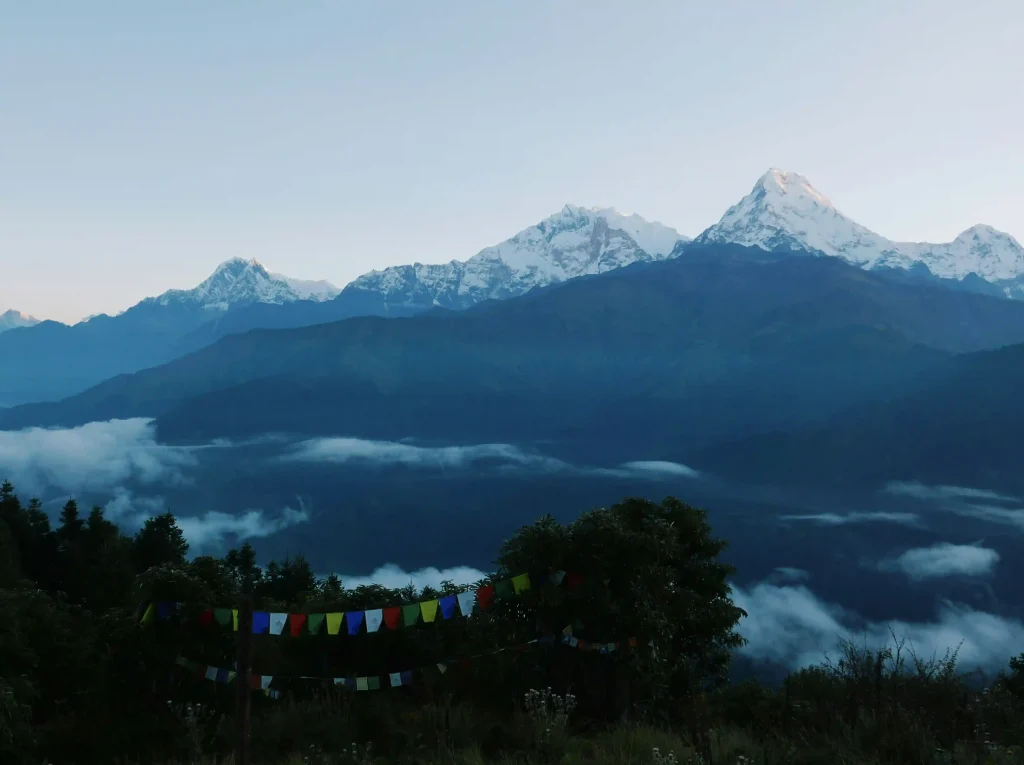
Timing is crucial for an optimal trekking experience. The best time to trek to Mardi in Nepal varies by season:
Spring Season (March to May)
Recommended: This is peak trekking season for excellent reasons:
- Clear weather with unobstructed mountain views
- Comfortable temperatures (10-20°C during the day)
- Rhododendron blooms create vibrant displays along the trail
- Excellent visibility for photography
- Moderate trail traffic
Autumn Season (September to November)
Highly Recommended: The most popular trekking season:
- Crystal-clear skies after monsoon rains
- Stable weather patterns with minimal precipitation
- Lush, green landscapes from recent rains
- Comfortable temperatures (5-15°C during the day)
- Perfect conditions for high-altitude trekking
- Major festivals like Dashain and Tihar add cultural richness
Winter Season (December to February)
For Experienced Trekkers:
- Snow-covered landscapes create stunning scenery
- Quieter trails with fewer trekkers
- Extremely cold temperatures, especially at high camps (-5 to -15°C)
- Risk of trail closures due to heavy snowfall
- Requires proper winter trekking gear
Monsoon Season (June to August)
Not Recommended:
- Heavy rainfall creates slippery, dangerous trails
- Leeches are prevalent in lower elevations
- Obscured mountain views due to clouds
- Higher risk of landslides
- However, lush greenery can be beautiful for nature enthusiasts
Detailed Mardi Himal Base Camp Trek Itinerary
Here’s a comprehensive 11-day itinerary designed to balance adventure, acclimatization, and cultural experience:
Day 1: Arrival in Kathmandu (1,400m)
Your adventure begins in Kathmandu, Nepal’s vibrant capital:
- Explore UNESCO World Heritage Sites like Swayambhunath (Monkey Temple) and Kathmandu Durbar Square
- Visit bustling markets in Thamel for last-minute gear
- Attend a pre-trek briefing with your guide
- Rest and acclimatize for the journey ahead
- Accommodation: Overnight stay at a hotel in Kathmandu
Day 2: Kathmandu to Pokhara (820m) – 6-7 hours or 30 minutes by flight
Travel to Pokhara, the gateway to the Annapurna region:
- Scenic drive or 30-minute flight with mountain views
- Explore Phewa Lake and the lakeside area
- Visit the International Mountain Museum
- Optional: Paragliding or boating on the lake
- Final gear check and preparation
- Accommodation: Hotel in Pokhara
Day 3: Pokhara to Nayapul to Tikhedhunga (1,540m) – 4-5 hours
Begin your trek with a gentle introduction:
- 1.5-hour drive from Pokhara to Nayapul (1,070m)
- Trek through terraced fields and traditional villages
- Cross suspension bridges over the Modi Khola river
- Pass through Birethanti village
- Gradual ascent to Tikhedhunga
- Trekking Distance: 10km
- Accommodation: Teahouse in Tikhedhunga
Day 4: Tikhedhunga to Ghorepani (2,874m) – 6-7 hours
A challenging but rewarding ascent:
- Climb the famous 3,300+ stone steps from Tikhedhunga
- Trek through magnificent rhododendron forests
- Pass through Ulleri village (2,070m), one of the largest Magar settlements
- Continue ascending through Banthanti and Nangethanti
- Arrive at Ghorepani with stunning mountain views
- Trekking Distance: around 12km
- Elevation Gain: 1,334m
- Accommodation: Teahouse in Ghorepani
Day 5: Poon Hill Sunrise to Tadapani (2,630m) – 6-7 hours
The highlight of the Poon Hill experience:
- Pre-dawn hike (45 minutes) to Poon Hill viewpoint (3,210m)
- Witness a spectacular sunrise over Annapurna I, Dhaulagiri, Machapuchare, and other peaks
- Return to Ghorepani for breakfast
- Trek through dense oak and rhododendron forests to Tadapani
- Possible wildlife sightings: Himalayan monkeys, various bird species
- Trekking Distance: Around 10km
- Accommodation: Teahouse in Tadapani
Day 6: Tadapani to Forest Camp (2,600m) – 5-6 hours
Enter the quieter Mardi Himal trail:
- Descend through beautiful forest landscapes
- Cross streams and traverse hillsides
- Less crowded trails compared to the main Annapurna routes
- Arrive at peaceful Forest Camp Mardi Himal, surrounded by dense vegetation
- Trekking Distance: Around 8km
- Accommodation: Basic teahouse at Forest Camp
Day 7: Forest Camp to High Camp (3,580m) – 4-5 hours
The landscape dramatically transforms:
- Ascend through changing vegetation zones
- Dense forest gives way to alpine meadows
- Spectacular views of Machapuchare, Annapurna South, and Hiunchuli
- Rocky, exposed terrain with prayer flags
- Arrive at High Camp with panoramic mountain vistas
- Trekking Distance: 6km
- Elevation Gain: 980m
- Accommodation: Basic lodge at High Camp
Day 8: High Camp to Mardi Himal Base Camp (4,500m) and Return to Low Camp (3,050m) – 7-8 hours
The trek’s pinnacle experience:
- Early morning start to Mardi Himal Base Camp (4,500m)
- Steep ascent through rocky terrain
- Breathtaking 360-degree views: Annapurna I, Annapurna South, Machapuchare, Hiunchuli, and Mardi Himal
- Stand in awe beneath towering Himalayan giants
- Descend to Low Camp (Badal Danda) for overnight
- Trekking Distance: around 10km
- Maximum Elevation: 4,500m
- Accommodation: Teahouse at Low Camp
Day 9: Low Camp to Siding Village (1,750m) – 5-6 hours
Descend through diverse landscapes:
- Trek through forests and terraced farmlands
- Arrive at authentic Siding Village
- Experience the traditional Gurung lifestyle and hospitality
- Enjoy home-cooked meals with local families
- Celebrate the completion of your high-altitude trek
- Trekking Distance: around 9km
- Accommodation: Community lodge or homestay
Day 10: Siding to Pokhara via Lumre – 5-6 hours
Complete your trekking circuit:
- Morning trek to Lumre village
- Drive back to Pokhara (1.5-2 hours)
- Relax by Phewa Lake and celebrate your achievement
- Optional: Visit cafes, get a massage, or explore Pokhara
- Accommodation: Hotel in Pokhara
Day 11: Pokhara to Kathmandu
Return to the capital:
- Drive or fly back to Kathmandu
- Free time for souvenir shopping in Thamel
- Optional: Extend your stay to explore more of Nepal
- Farewell dinner with cultural show
Essential Preparation and Tips for the Trek
Physical Fitness Requirements
The Mardi Himal Trek difficulty is rated as moderate, but it also depends on the trekking route. Proper preparation includes:
- Start training 6-8 weeks before departure
- Cardiovascular exercises: Running, cycling, swimming (3-4 times weekly)
- Strength training: Focus on legs, core, and back muscles
- Practice hiking with a loaded backpack (5-7kg)
- Build endurance for 5-7 hours of daily trekking
- Stair climbing to simulate uphill trekking
Packing List Essentials
Clothing Layers:
- Base layers: Moisture-wicking thermal tops and bottoms
- Mid-layers: Fleece jacket and insulated down jacket
- Outer layer: Waterproof and windproof jacket and pants
- Trekking pants (quick-dry) and shorts
- Warm hat, sun hat, and neck gaiter
- Gloves (liner and insulated)
- 3-4 pairs of trekking socks (wool or synthetic)
Footwear:
- Good quality hiking shoes or trekking boots(waterproof, ankle support)
- Camp shoes or sandals for teahouses
- Gaiters (optional, for snow/mud)
Gear and Equipment:
- Backpack (40-50L) with rain cover
- Sleeping bag (rated to -10°C for spring/autumn)
- Trekking poles (highly recommended)
- Headlamp with extra batteries
- Water bottles (2L capacity) or hydration bladder
- Water purification tablets or a filter
- Sunglasses (UV protection) and sunscreen (SPF 50+)
- First aid kit and personal medications
Other Essentials:
- Passport and permit copies
- Cash (Nepali rupees for teahouses)
- Camera and power bank
- Toiletries and a quick-dry towel
- Snacks: Energy bars, nuts, chocolate
Required Permits and Documents
Mandatory Permits:
- Annapurna Conservation Area Permit (ACAP):
- Cost: NPR 3,000 (approximately $23 USD) for foreigners
- Obtained in Kathmandu or Pokhara
- Supports conservation efforts in the region
- Trekkers’ Information Management System (TIMS) Card:
- Cost: NPR 2,000 (approximately $15 USD) for organized trekkers
- Available through registered trekking agencies
- Required for safety and tracking purposes
Important Documents:
- Passport with at least 6 months’ validity
- Passport-size photos (4-6 copies)
- Travel insurance covering high-altitude trekking (up to 5,000m)
- Emergency contact information
Altitude Sickness Prevention
Acute Mountain Sickness (AMS) is a serious concern. Follow these guidelines:
Prevention Strategies:
- Ascend gradually (no more than 500m elevation gain per day above 3,000m)
- Stay hydrated: Drink 3-4 liters of water daily
- Avoid alcohol and smoking
- Eat high-carbohydrate meals
- Listen to your body and communicate symptoms
Symptoms to Watch For:
- Headache, nausea, dizziness
- Loss of appetite, fatigue
- Shortness of breath, insomnia
- Rapid heartbeat
Action Plan:
- If symptoms are mild: Rest, hydrate, and don’t ascend further
- If symptoms persist or worsen: Descend immediately
- Carry Diamox (consult your doctor before the trek)
- Your guide is trained in altitude sickness recognition
Hydration and Nutrition
Proper nutrition during trekking is crucial:
- Drink frequently throughout the day (small sips)
- Boil water, use purification tablets, or filters
- Eat substantial meals at teahouses (dal bhat is unlimited because Dal Bhat Power, 24 Hour!)
- Carry high-energy snacks: Trail mix, energy bars, dried fruits
- Avoid raw vegetables at higher altitudes
- Hot drinks help with acclimatization (herbal tea, lemon honey tea)
Hiring Guides and Porters
Benefits of Hiring a Guide:
- Local expertise and route knowledge
- Cultural interpretation and language assistance
- Safety and emergency response
- Navigation and logistics support
- Cost: $25-35 USD per day
Benefits of Hiring a Porter:
- Carries 15-20kg of your gear
- Allows you to trek with a lighter daypack
- Employs local communities
- Cost: $20-25 USD per day
Finding Reliable Services:
- Book through registered trekking agencies in Nepal
- Check reviews and credentials
- Ensure guides have proper licenses and insurance
- Tip guides and porters at trek completion (10-15% of their wages)
Mardi Himal Trek Cost Breakdown
The Mardi Himal Trek Cost varies depending on your style of travel, duration, and level of comfort. On average, a standard trek price range starts from $700, depending on whether you go independently or with a guide and porter. The basic trekking price without a porter is much less if you choose to carry your necessities yourself:
Budget Breakdown for the Trek
Basic Package (Independent Trekker): Starting from $350 per person for a group
If you want a basic package with no guide or porter, we can customize one for you! This includes your permits (around $40), accommodation in teahouses ($3–5 per night), and daily meals that can add up to $250 for a 10-day trek. Transportation to and from the trailhead, such as buses or flights from Kathmandu to Pokhara, generally costs around $60, while miscellaneous expenses might add another $50.
Standard Package (With Guide): $700-900 USD
- All items above
- Licensed trekking guide: $300
- Insurance and tips: $100
Comfort Package (Guide + Porter): $900-1,200 USD
- All standard items
- Porter services: $250
- Better accommodation upgrades: $100
- Additional logistics: $50
Facilities:
- Simple twin or dormitory rooms
- Shared bathrooms (squat toilets at higher altitudes)
- Communal dining areas with heating in the middle, known as Bukhari (minimal extra charge)
- Basic bedding (bring your own sleeping bag, if possible)
- Limited electricity (solar power at higher camps)
Comfort Levels by Location:
- Lower elevations (Tikhedhunga-Ghorepani): Better facilities, attached bathrooms available
- Mid-elevations (Tadapani-Low Camp): Basic but comfortable
- High elevations (High Camp-Base Camp): Very basic, minimal amenities
Food and Dining
Typical Menu Items:
- Dal Bhat: Traditional Nepali meal with unlimited refills (highly recommended for energy because we believe in Dal Bhat Power, 24 Hour!)
- Tibetan Bread: Fried bread with honey, jam, or cheese
- Momos: Nepali dumplings (vegetable, chicken, or buff)
- Noodle soups: Thukpa, chow mein, instant noodles
- Rice dishes: Fried rice, vegetable rice
- Pasta and pizza: Available at lower elevations
- Porridge and cereals: For breakfast
- Hot drinks: Milk tea, herbal tea, hot lemon, coffee
Dietary Considerations:
- Vegetarian and vegan options are widely available
- Limited meat variety (chicken, buff)
- Food prices increase with altitude
- Hygiene standards decrease at higher elevations
Safety and Health Considerations
Travel Insurance
Travel Insurance is essential for trekking in Nepal, as mountain adventures come with unpredictable weather, altitude challenges, and remote locations. Having the right insurance coverage is necessary as it ensures peace of mind and financial protection.
For trekking in Nepal, a good insurance policy covers:
- Medical coverage up to 5,000m altitude, even if the Mardi Trek goes above 4,000 m+
- Emergency helicopter evacuation
- Trip cancellation and interruption
- Lost or stolen baggage
- Repatriation coverage
Note: Some recommended providers who are reliable for insurance are World Nomads, IMG Global, and others, for your peace of mind in any corner of the world.
Emergency Protocols
In Case of Emergency:
- Immediately contact your guide and teahouse owners
- Satellite phones are available for emergency communication
- Helicopter rescue: Requires insurance confirmation
- Nearest medical facilities in Pokhara
- Emergency numbers: Nepal Police 100, Nepal Tourism Board 01-4247041
Health Tips
- Carry a comprehensive first aid kit
- Bring personal medications with prescriptions
- Hand sanitizer for hygiene
- Blister care (crucial for foot health)
- Digestive aids for stomach upset
- Altitude sickness medication (Diamox)
Environmental Responsibility
If you love mountains, you must be aware that the Himalayan ecosystem is fragile. To let future generations become travelers, we must preserve these ecosystems for them. Sustainable Trekking in Nepal is a choice you should make to let them enjoy these pristine landscapes just as we do today!
Leave No Trace Principles
Follow this principle while you trek in Nepal to reduce your environmental footprint. While trekking in Nepal:
- Pack out all non-biodegradable waste
- Use designated toilets or bury waste properly
- Avoid single-use plastics
- Refill water bottles instead of buying bottled water
- Stay on marked trails
- Don’t pick flowers or disturb wildlife
- Minimize campfire impact
Supporting Local Communities
- Purchase locally made products to show respect and support local businesses
- Eat at local teahouses to experience the way of living
- Respect cultural sites and traditions. Remember to take your shoes out while entering a temple.
- Hire local guides and porters to promote employment and for an easier experience.
- Ask permission before photographing people, especially in rural parts of Nepal.
- Learn basic Nepali phrases (Namaste for Greetings, Dhanyabad for Thank You!) because gestures like these go a long way in showing respect and building a friendly connection.
Rhododendron Blooms along the Poon Hill Route
The rhododendron forests of Poon Hill make this trek Nepal’s most spectacular trek in Spring when the national flowers of Nepal are in full bloom. The Ghorepani trail turns into a floral paradise every spring at 3,210 m with the best sunrise view showcasing the panoramic mountains.
March to April is the peak rhododendron season when the forests are filled with Red, Pink, and White blooming rhododendrons. The ancient rhododendron forests surrounding Ghorepani feature over 30 species, with some trees towering 40 feet high, creating stunning floral tunnels along the trekking route.
The Poon Hill trek combines Nepal’s national flower display with panoramic views of Dhaulagiri, Annapurna, and Machhapuchhre (Fishtail). This UNESCO-recognized biodiversity hotspot supports rare wildlife, including Himalayan monals, red pandas, and various deer species. Local communities have preserved these forests for generations, making it an eco-tourism success story.
Comparing Mardi Himal to Other Popular Treks
Mardi Himal vs Annapurna Base Camp: Which Trek is Right for You?
Both treks are famous for their iconic trekking routes with stunning Himalayan views and rich cultural encounters. However, they cater to slightly different experiences in terms of crowd, difficulty, and overall experience.
Quick Comparison Overview
| Feature | Mardi Himal | Annapurna Base Camp |
| Duration | 7-10 days | 10-14 days |
| Max Altitude | 4,500m | 4,130m |
| Cost | Starts from $700 | Starts from $900 |
| Crowd Level | Low | High |
| Difficulty | Moderate (steeper) | Moderate (gradual) |
Mardi Himal is ideal for trekkers seeking solitude, affordability, and stunning views without extreme altitude or time commitment, while ABC offers more facilities and dramatic scenery with an opportunity to experience two base camps at a time!
Why Mardi Trek via Ghorepani Poon Hill?
Combining the Mardi Himal Base Camp Trek with the Ghorepani Poon Hill Trek is the best choice because it creates the ultimate experience in the Annapurna Region. This extended trek not only makes the journey more exciting but also comes with benefits such as:
- Creates a better value for the trekking permits in Nepal
- Poon Hill consists of the largest Rhododendron forests, the national flower of Nepal, which makes the forests look spectacular during full bloom in Spring
- Since you can acclimatize along the way, it reduces the risk of altitude sickness significantly
- The Poon Hill Sunrise makes your trip worth it with a 180-degree view of the panoramic mountains
- Best for photographers and nature lovers, as you get to experience maximum photographic variety with biodiversity
Conclusion
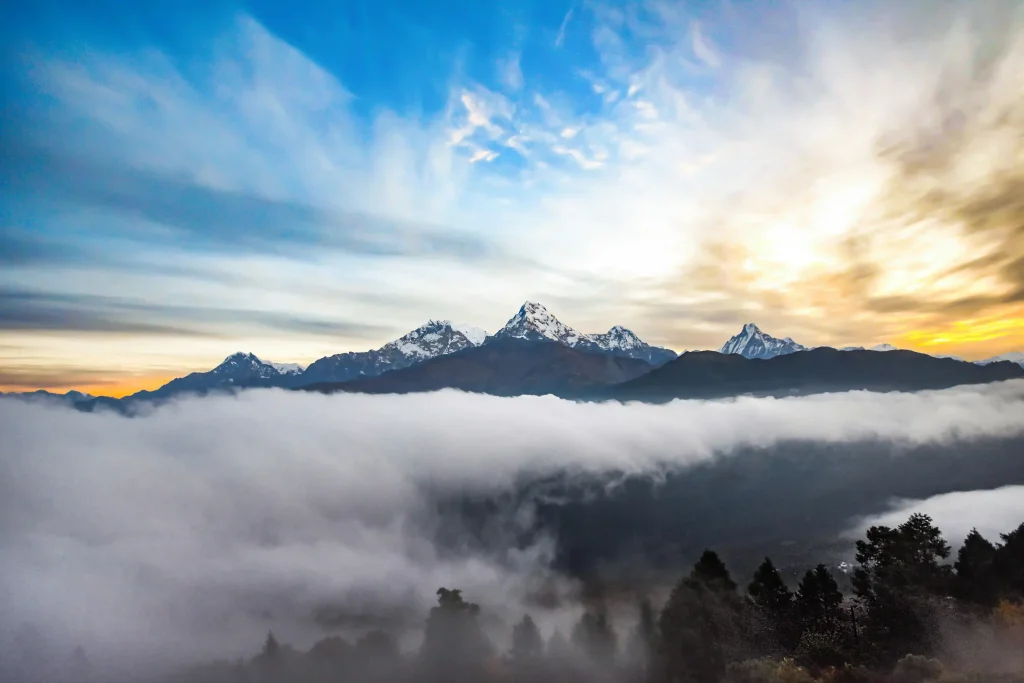
The Mardi Himal Trek via Poon Hill is an extraordinary journey combining diverse landscapes, cultural richness, and spectacular mountain views that can be customized just for you! This trek offers the perfect balance between challenge and accessibility, making it ideal for both experienced trekkers and adventurous beginners.
From the iconic sunrise at Poon Hill to the intimate beauty of Mardi Himal Base Camp, every day presents new wonders. The warmth of local communities, the serenity of less-crowded trails, and the majesty of the Annapurna Range create an unforgettable Himalayan experience.
Whether you seek adventure, cultural immersion, or personal challenge, this trek delivers on all fronts. With proper preparation, the right season, and an open heart, you’ll create memories that last a lifetime.
Ready to embark on your Himalayan adventure? Start planning and book your Mardi Himal Trek today and discover why this hidden gem is becoming one of Nepal’s most beloved trekking routes.
Namaste and happy trekking!
Disclaimer: Trail conditions, prices, and regulations are subject to change. Always verify current information with local authorities or registered trekking agencies before your departure.
FAQs(Frequently Asked Questions)
1. Where is Mardi Himal Located?
Mardi Himal Trek is located in the Annapurna Region of Nepal near Pokhara. The distance is 31 km from Pokhara within the Annapurna Conservation Area in the Gandaki Province.
2. Can I get a visa for Nepal on arrival?
Yes, tourists from most nationalities get a visa on arrival at Tribhuvan International Airport and the land border. The visa is valid for 15, 30, or 90 days, which covers sightseeing, trekking, and visiting friends and family.
3. Can I see rhododendrons all year-round in Poon Hill?
No, Rhododendrons in Poon Hill bloom seasonally, usually from March to May, where hillsides are covered in shades of red, pink, and white rhododendrons. Other times of the year, the trees are just green without flowers.
4. Can I extend my stay after the trek?
Yes, you can extend your stay in Nepal after completing the trek, provided your tourist visa is still valid. Most travelers choose to spend extra days in cities like Kathmandu, Pokhara, or Chitwan to explore cultural sites, enjoy lakes and lakeside activities, or go on short excursions. If your visa is about to expire, you can apply for a visa extension at the Department of Immigration in Kathmandu.
5. What types of accommodations are available during the trek?
Teahouses are available throughout the way for accommodations during the trek. Most trekkers are family-run businesses, offering basic rooms, meals, and shared bathrooms. Some areas have guesthouses or upgraded lodges with better facilities, hot showers, and Wi-Fi for a small extra fee.
6. Can I buy a SIM card in Nepal?
Yes, you can easily buy a local SIM card in Nepal at airports, mobile shops, or authorized retailers. You’ll need your passport for registration. Major providers like Ncell and Nepal Telecom offer data and call packages suitable for travelers. It is recommended to buy an NTC Sim, but the signal may be limited at higher altitudes.
7. How do you avoid altitude sickness on the Mardi Himal Trek via Ghorepani Poon Hill?
You can prevent altitude sickness in the Mardi Himal Trek via Ghorepani Poon Hill by ascending slowly and allowing time for acclimatization at key stops like Ghorepani and Poon Hill. It is also recommended to stay hydrated, eat light meals, and avoid alcoholic drinks. If you experience symptoms of altitude sickness, inform your guide immediately.
8. Is the Ghorepani Poon Hill with Mardi Himal Trek Itinerary customizable?
Yes, if you are not satisfied with this itinerary, Ghorepani Poon Hill with Mardi Himal Trek can be customized. This itinerary can be customized as per your preference, time availability, and your other choices.
9. Do you have any special packages for solo travelers?
Yes, there are trekking packages available at Mardi Himal Treks and Expeditions for solo travelers to meet their unique personal needs. Every itinerary can be customized because we welcome all kinds of travelers.
10. Is the Mardi Himal Trek safe?
Yes, the Mardi Himal Trek is considered safe for those with moderate fitness, but remember, it requires preparation and precautions to avoid any accidents. Hiring a licensed guide from a registered trekking company in Nepal is recommended for navigation, local knowledge, and emergency support.
11. Is the Poon Hill Trek difficult?
The Poon Hill Trek is considered moderate and one of the most beginner-friendly treks in Nepal. While some sections may be steep, this trek can be completed at a comfortable pace with basic fitness and preparation.


